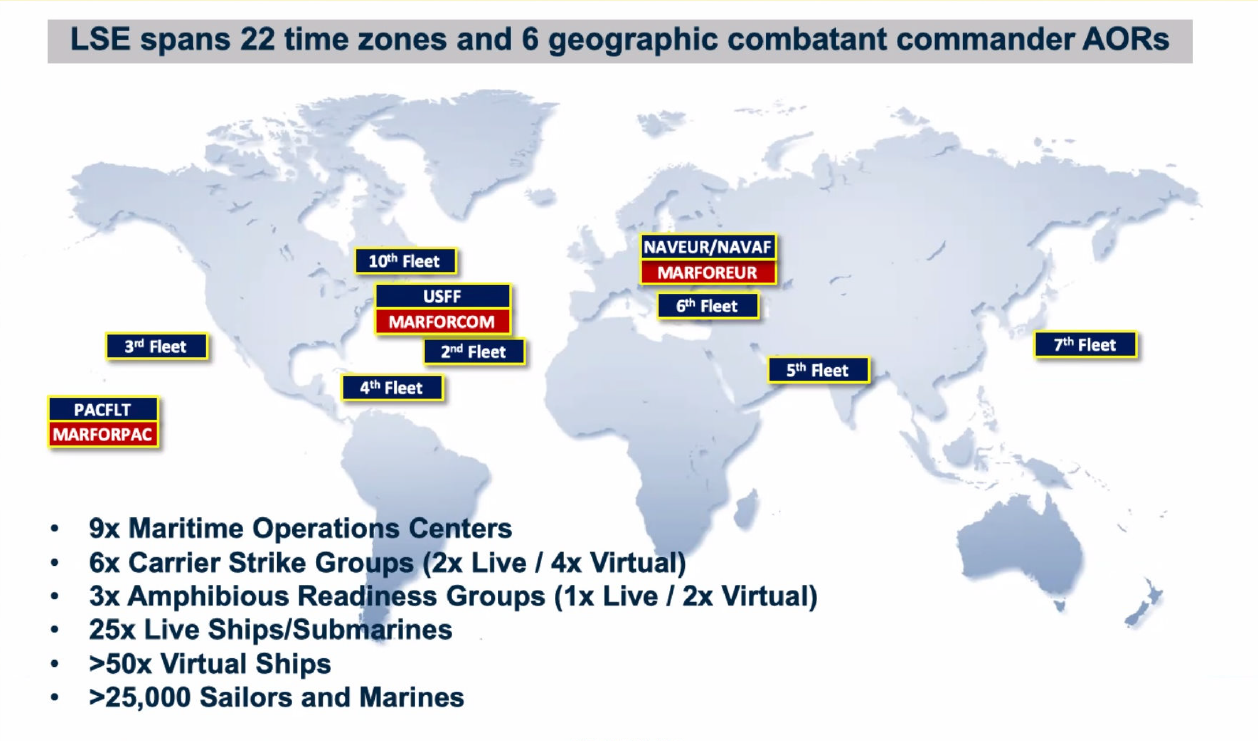
The Navy and Marines are taking a second crack at an exercise that will simulate a massive global conflict and connect the actions from a single sailor at a radar console up through the decisions made by the Secretary of Defense, service officials announced on Monday.
Large Scale Exercise 2023 kicks off next month and will link 25,000 sailors and Marines across 22 time zones, seven fleets, six U.S. combatant commands in a blend of live and virtual training that will test the suppositions of key warfighting concepts for both services.
The Marines and the Navy believe the future of maritime conflict will require units to be spread across thousands of miles and have them strike adversaries simultaneously and then disperse.
“Distributing [the force] allows us to actually do more with that force so that it punches above its weight,” Fleet Forces commander Adm. Daryl Caudle told reporters on Monday.

Caudle and Lt. Gen. Brian Cavanaugh, commanding general of Fleet Marine Forces Atlantic, will lead the exercise.
The command and control and logistics challenges of linking scores of ships and aircraft and ground units together prompted Chief of Naval Operations Adm. Mike Gilday to order the original exercise series, which ran for the first time in 2021. LSE 2021 linked the Navy’s Distributed Maritime Operations, the Marines’ Expeditionary Advanced Base Operations and Littoral Operations in a Contested Environment together in one worldwide event.
While the planners were careful to single out different countries, concepts like DMO and EABO and LOCE are designed to maximize the advantages of a smaller more technologically advanced U.S. force against a larger naval adversary like China.
“The idea of [DMO] is this notion that we’re going to sail at such a distance and in such a formation that we don’t present ourselves as an obvious military formation that brings to their enemy fires, but while still maintaining the ability to provide mutual support to one another,” U.S. Pacific Fleet commander Adm. Sam Paparo said in February.
LSE 2023 – running from Aug. 9th to 18th – allows the Navy and Marines to prove how it will be able to link the dispersed formations to operate together.
“We want to build a more competent and lethal force; we want to be able to demonstrate that we can globally synchronize this exercise. And then finally, we want to be able to show that we can fight and win against our adversaries using the live virtual constructive training environment,” Capt. Chris Narducci, lead exercise planner told reporters on Monday.
Fleet Forces and the Marines folded in other training events like the amphibious exercises Bold Alligator and Dawn Blitz and Composite Unit Training Exercises for carrier strike groups to the larger LSE 23. So, if a sailor at a sonar console makes a tactical decision as part of the COMPTUEX for the Eisenhower Carrier Strike Group, it could affect the scenario across the globe as part of the live, virtual and constructive training.
In total, the exercise will encompass six carriers strike groups (two live, four virtual), three amphibious ready groups (one live, two virtual), 25 live ships and more than 50 virtual ships.
All those inputs will be routed to nine maritime operations centers and then to the central command node in Norfolk at the Naval Warfare Development Center. Just running the exercise will take more than a thousand people.
Getting all the pieces to work together is the key to exercise.
“The amount of military capacity and capabilities can be strained in any conflict with a near peer competitor, the ability to synchronize those operations is extremely important. There is an old boxing analogy that goes: precision beats power and timing beat speed every time,” Caudle said.
“To conduct high and modern warfare in a distributed maritime operational construct, you have to work on precision and timing. To do that, you got to link together these maritime operations centers so that we have the same operational picture.”
Based on the lessons of first exercise from two years ago, the services expanded the scope and added an additional command and control element to include 15 retired general and flag officers to act as senior leaders in the exercise – including former U.S. Pacific Fleet commander Adm. Scott Swift and former U.S. Naval Forces Europe commander Adm. Jamie Foggo.
“What you have to do is you have to fight with the force you have and then adjust its ability and its capabilities and its training and how you posture it and and how you train to it and teach the sailors and Marines to fight in the environment, Caudle said.
“Our ability to distribute our maritime forces, and ability to command and control that, because distributing that allows us to actually do more with that force. So that punches above its weight. But also, I’ve got a Marine Corps that I can bring to bear.”





